YAMAHA FX HO 2014 Manual Online
Manufacturer: YAMAHA, Model Year: 2014, Model line: FX HO, Model: YAMAHA FX HO 2014Pages: 114, PDF Size: 5.13 MB
Page 81 of 114
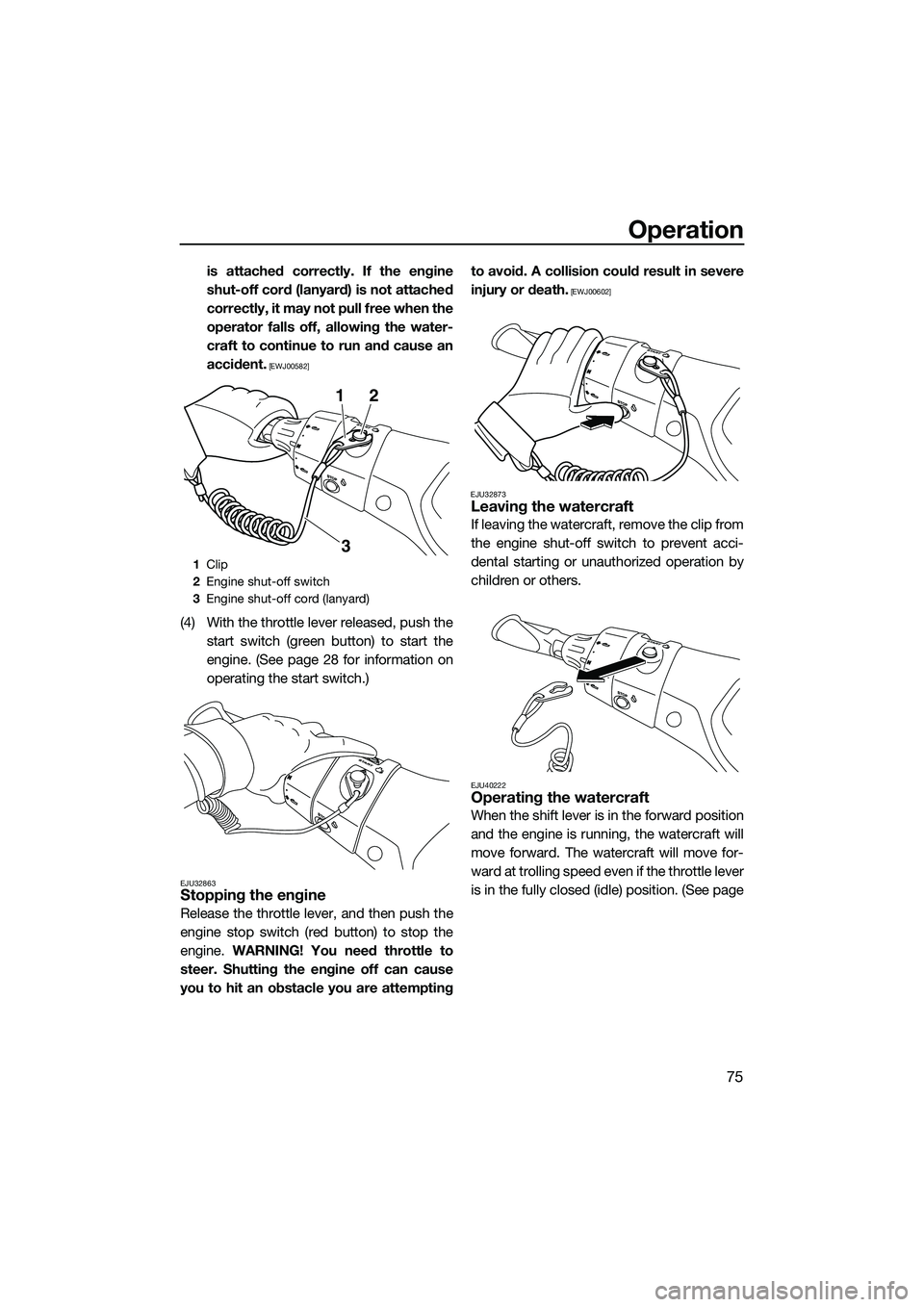
Operation
75
is attached correctly. If the engine
shut-off cord (lanyard) is not attached
correctly, it may not pull free when the
operator falls off, allowing the water-
craft to continue to run and cause an
accident.
[EWJ00582]
(4) With the throttle lever released, push thestart switch (green button) to start the
engine. (See page 28 for information on
operating the start switch.)
EJU32863Stopping the engine
Release the throttle lever, and then push the
engine stop switch (red button) to stop the
engine. WARNING! You need throttle to
steer. Shutting the engine off can cause
you to hit an obstacle you are attempting to avoid. A collision could result in severe
injury or death.
[EWJ00602]
EJU32873
Leaving the watercraft
If leaving the watercraft, remove the clip from
the engine shut-off switch to prevent acci-
dental starting or unauthorized operation by
children or others.
EJU40222Operating the watercraft
When the shift lever is in the forward position
and the engine is running, the watercraft will
move forward. The watercraft will move for-
ward at trolling speed even if the throttle lever
is in the fully closed (idle) position. (See page
1 Clip
2 Engine shut-off switch
3 Engine shut-off cord (lanyard)
12
3
UF2T72E0.book Page 75 Monday, July 22, 2013 2:26 PM
Page 82 of 114
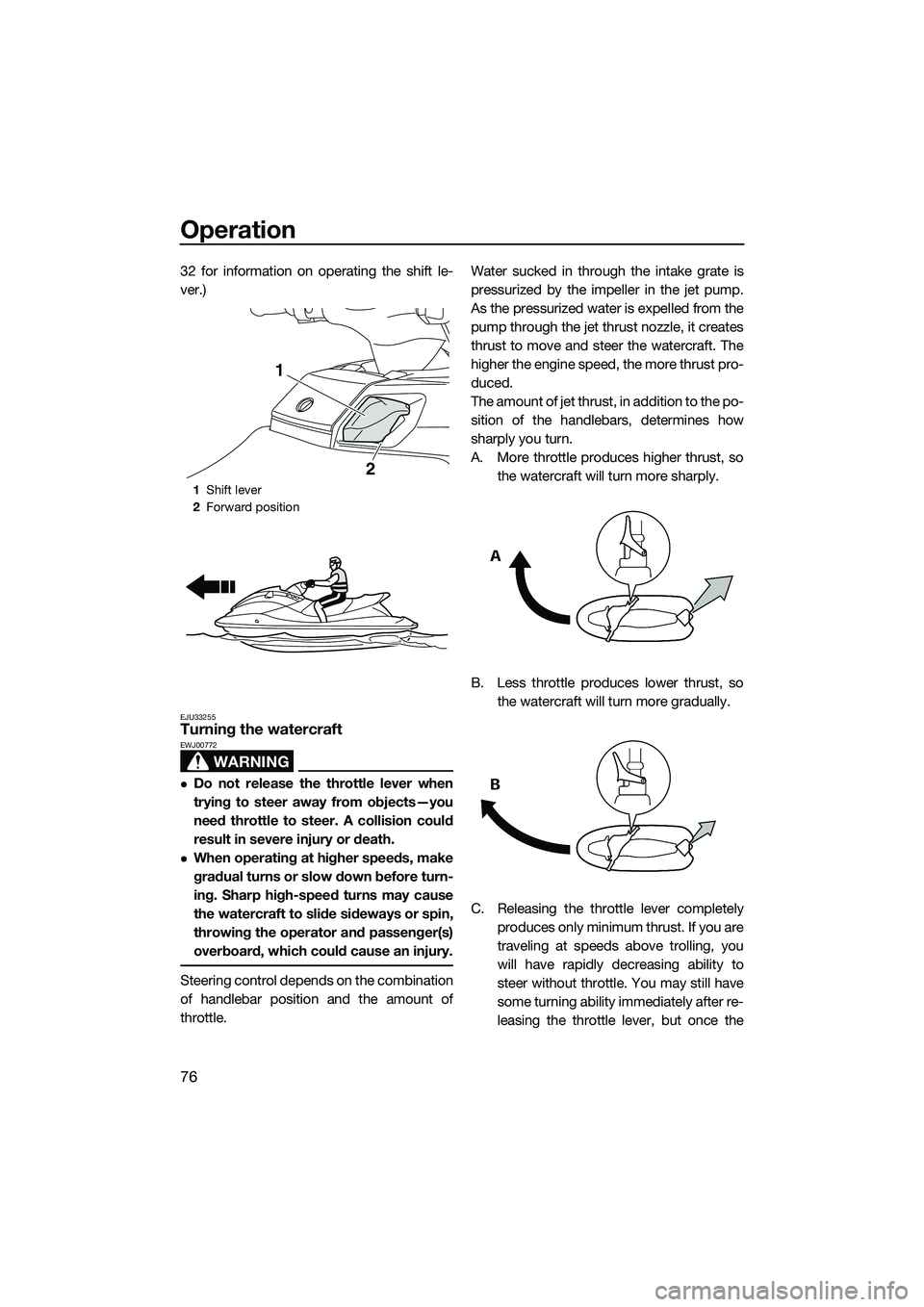
Operation
76
32 for information on operating the shift le-
ver.)
EJU33255Turning the watercraft
WARNING
EWJ00772
Do not release the throttle lever when
trying to steer away from objects—you
need throttle to steer. A collision could
result in severe injury or death.
When operating at higher speeds, make
gradual turns or slow down before turn-
ing. Sharp high-speed turns may cause
the watercraft to slide sideways or spin,
throwing the operator and passenger(s)
overboard, which could cause an injury.
Steering control depends on the combination
of handlebar position and the amount of
throttle.Water sucked in through the intake grate is
pressurized by the impeller in the jet pump.
As the pressurized water is expelled from the
pump through the jet thrust nozzle, it creates
thrust to move and steer the watercraft. The
higher the engine speed, the more thrust pro-
duced.
The amount of jet thrust, in addition to the po-
sition of the handlebars, determines how
sharply you turn.
A. More throttle produces higher thrust, so
the watercraft will turn more sharply.
B. Less throttle produces lower thrust, so the watercraft will turn more gradually.
C. Releasing the throttle lever completely produces only minimum thrust. If you are
traveling at speeds above trolling, you
will have rapidly decreasing ability to
steer without throttle. You may still have
some turning ability immediately after re-
leasing the throttle lever, but once the
1Shift lever
2 Forward position
1
2
UF2T72E0.book Page 76 Monday, July 22, 2013 2:26 PM
Page 83 of 114
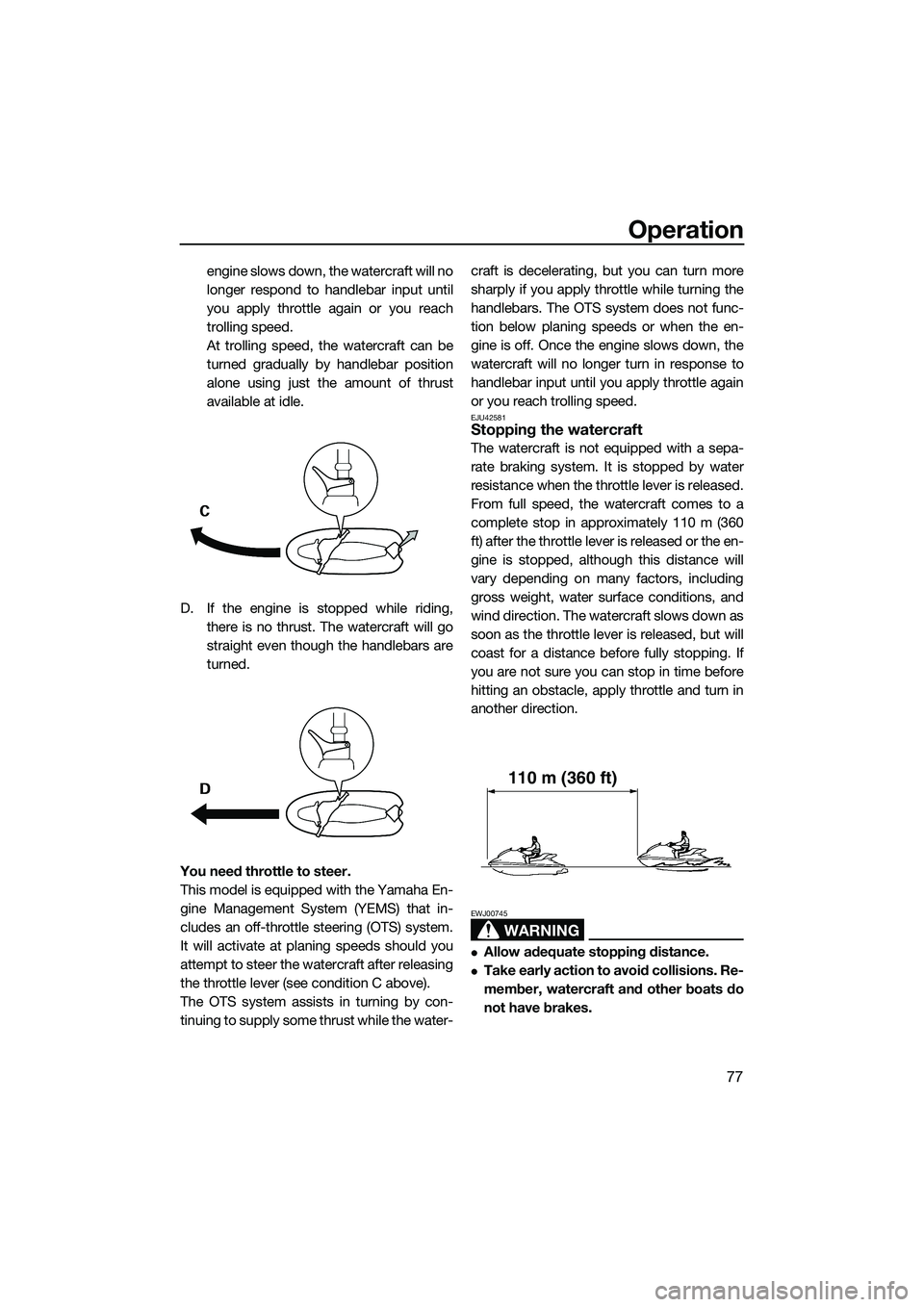
Operation
77
engine slows down, the watercraft will no
longer respond to handlebar input until
you apply throttle again or you reach
trolling speed.
At trolling speed, the watercraft can be
turned gradually by handlebar position
alone using just the amount of thrust
available at idle.
D. If the engine is stopped while riding, there is no thrust. The watercraft will go
straight even though the handlebars are
turned.
You need throttle to steer.
This model is equipped with the Yamaha En-
gine Management System (YEMS) that in-
cludes an off-throttle steering (OTS) system.
It will activate at planing speeds should you
attempt to steer the watercraft after releasing
the throttle lever (see condition C above).
The OTS system assists in turning by con-
tinuing to supply some thrust while the water- craft is decelerating, but you can turn more
sharply if you apply throttle while turning the
handlebars. The OTS system does not func-
tion below planing speeds or when the en-
gine is off. Once the engine slows down, the
watercraft will no longer turn in response to
handlebar input until you apply throttle again
or you reach trolling speed.
EJU42581Stopping the watercraft
The watercraft is not equipped with a sepa-
rate braking system. It is stopped by water
resistance when the throttle lever is released.
From full speed, the watercraft comes to a
complete stop in approximately 110 m (360
ft) after the throttle lever is released or the en-
gine is stopped, although this distance will
vary depending on many factors, including
gross weight, water surface conditions, and
wind direction. The watercraft slows down as
soon as the throttle lever is released, but will
coast for a distance before fully stopping. If
you are not sure you can stop in time before
hitting an obstacle, apply throttle and turn in
another direction.
WARNING
EWJ00745
Allow adequate stopping distance.
Take early action to avoid collisions. Re-
member, watercraft and other boats do
not have brakes.
110 m (360 ft)
UF2T72E0.book Page 77 Monday, July 22, 2013 2:26 PM
Page 84 of 114
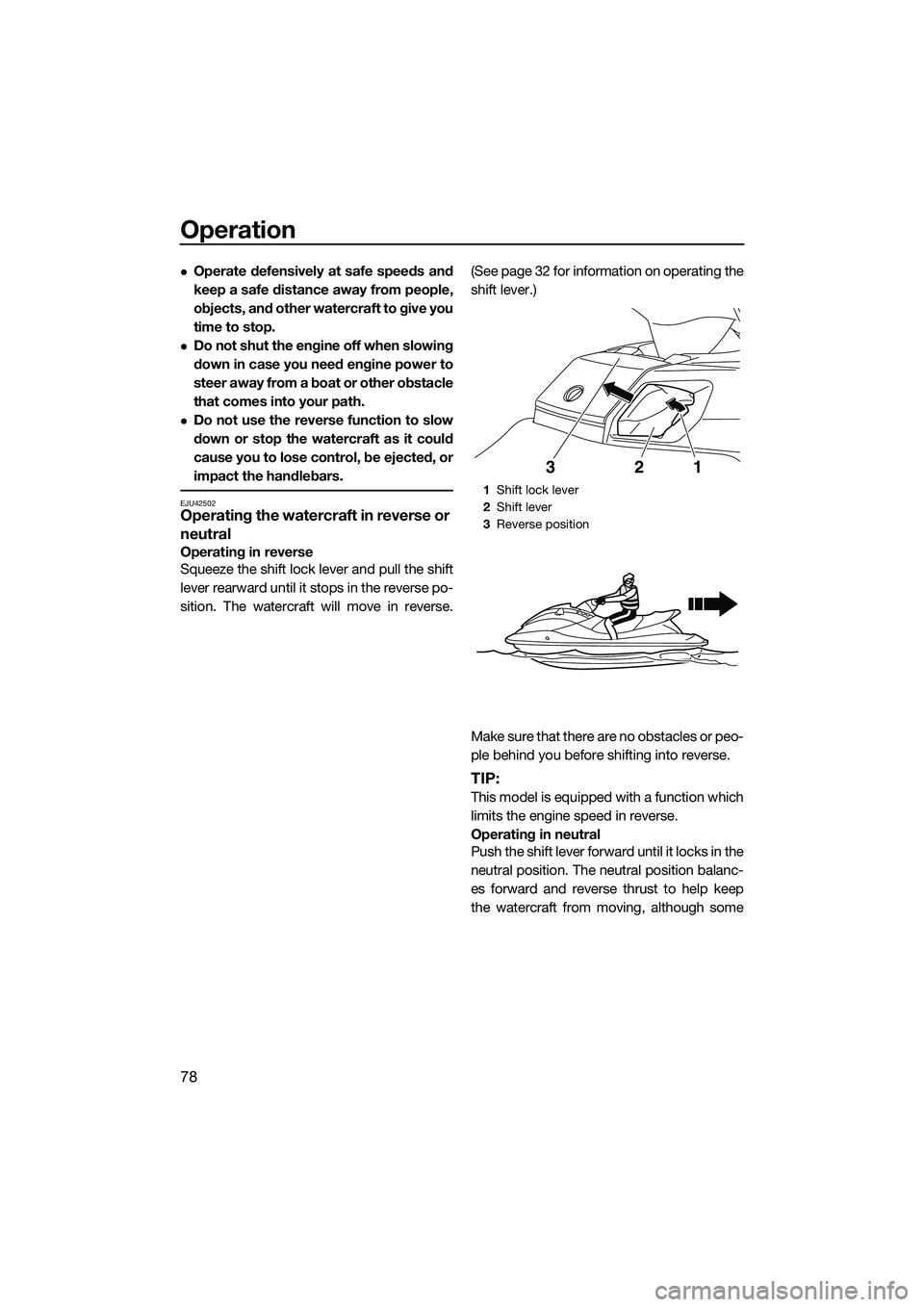
Operation
78
Operate defensively at safe speeds and
keep a safe distance away from people,
objects, and other watercraft to give you
time to stop.
Do not shut the engine off when slowing
down in case you need engine power to
steer away from a boat or other obstacle
that comes into your path.
Do not use the reverse function to slow
down or stop the watercraft as it could
cause you to lose control, be ejected, or
impact the handlebars.
EJU42502Operating the watercraft in reverse or
neutral
Operating in reverse
Squeeze the shift lock lever and pull the shift
lever rearward until it stops in the reverse po-
sition. The watercraft will move in reverse.(See page 32 for information on operating the
shift lever.)
Make sure that there are no obstacles or peo-
ple behind you before shifting into reverse.
TIP:
This model is equipped with a function which
limits the engine speed in reverse.
Operating in neutral
Push the shift lever forward until it locks in the
neutral position. The neutral position balanc-
es forward and reverse thrust to help keep
the watercraft from moving, although some
1
Shift lock lever
2 Shift lever
3 Reverse position
2
31
UF2T72E0.book Page 78 Monday, July 22, 2013 2:26 PM
Page 85 of 114
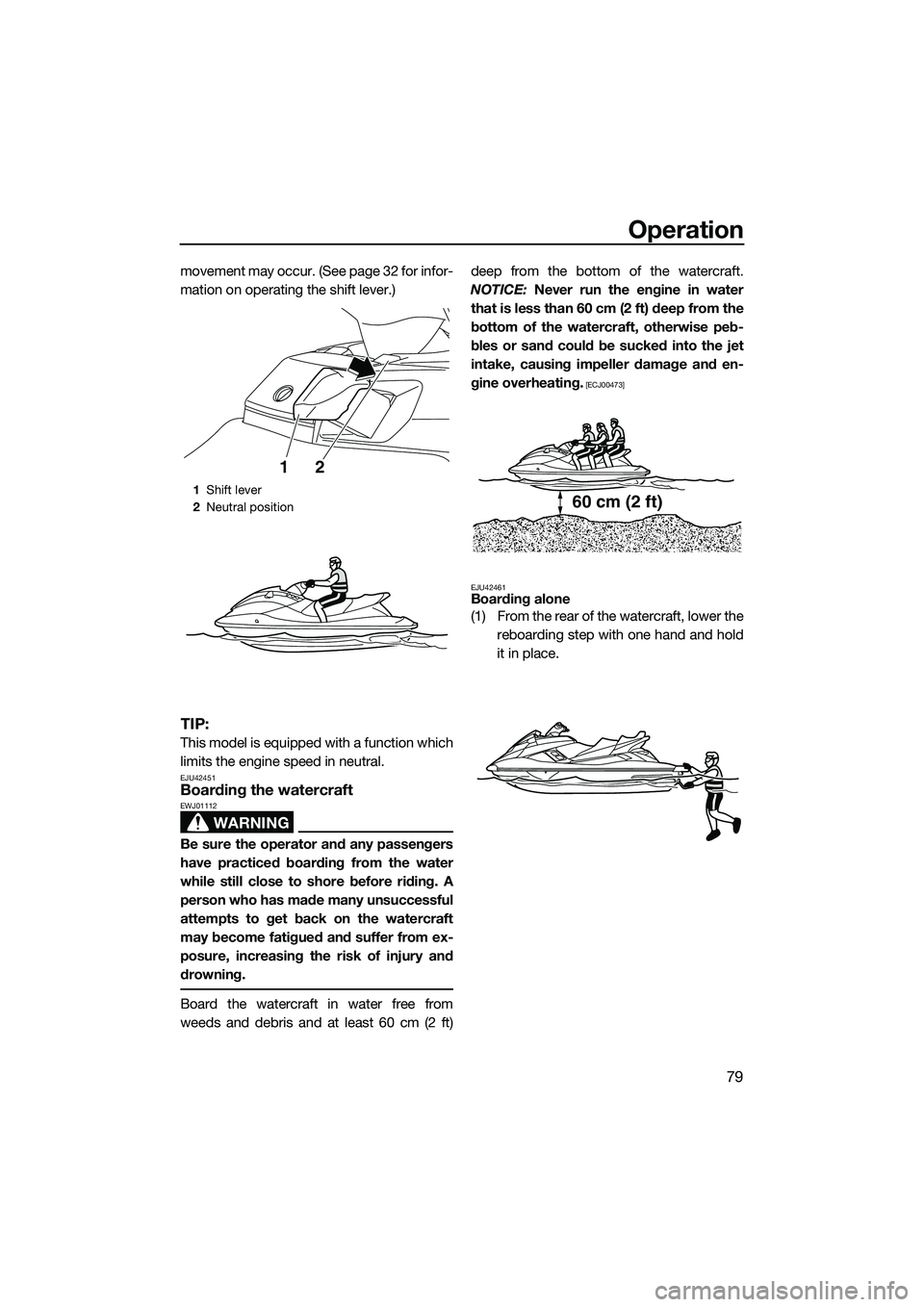
Operation
79
movement may occur. (See page 32 for infor-
mation on operating the shift lever.)
TIP:
This model is equipped with a function which
limits the engine speed in neutral.
EJU42451Boarding the watercraft
WARNING
EWJ01112
Be sure the operator and any passengers
have practiced boarding from the water
while still close to shore before riding. A
person who has made many unsuccessful
attempts to get back on the watercraft
may become fatigued and suffer from ex-
posure, increasing the risk of injury and
drowning.
Board the watercraft in water free from
weeds and debris and at least 60 cm (2 ft)deep from the bottom of the watercraft.
NOTICE: Never run the engine in water
that is less than 60 cm (2 ft) deep from the
bottom of the watercraft, otherwise peb-
bles or sand could be sucked into the jet
intake, causing impeller damage and en-
gine overheating.
[ECJ00473]
EJU42461
Boarding alone
(1) From the rear of the watercraft, lower the reboarding step with one hand and hold
it in place.
1Shift lever
2 Neutral position
12
60 cm (2 ft)
UF2T72E0.book Page 79 Monday, July 22, 2013 2:26 PM
Page 86 of 114
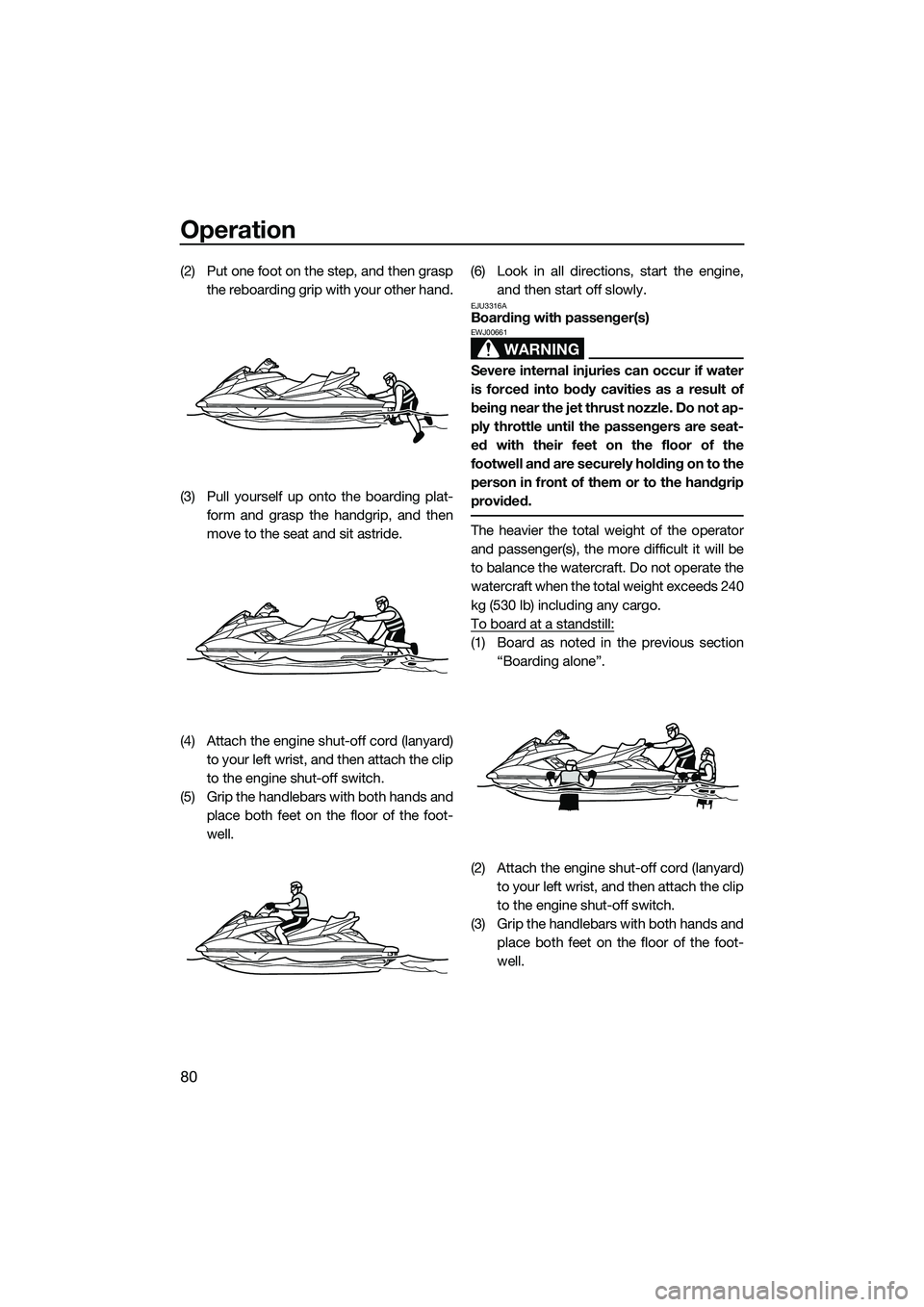
Operation
80
(2) Put one foot on the step, and then graspthe reboarding grip with your other hand.
(3) Pull yourself up onto the boarding plat- form and grasp the handgrip, and then
move to the seat and sit astride.
(4) Attach the engine shut-off cord (lanyard) to your left wrist, and then attach the clip
to the engine shut-off switch.
(5) Grip the handlebars with both hands and place both feet on the floor of the foot-
well. (6) Look in all directions, start the engine,
and then start off slowly.
EJU3316ABoarding with passenger(s)
WARNING
EWJ00661
Severe internal injuries can occur if water
is forced into body cavities as a result of
being near the jet thrust nozzle. Do not ap-
ply throttle until the passengers are seat-
ed with their feet on the floor of the
footwell and are securely holding on to the
person in front of them or to the handgrip
provided.
The heavier the total weight of the operator
and passenger(s), the more difficult it will be
to balance the watercraft. Do not operate the
watercraft when the total weight exceeds 240
kg (530 lb) including any cargo.
To board at a standstill:
(1) Board as noted in the previous section“Boarding alone”.
(2) Attach the engine shut-off cord (lanyard) to your left wrist, and then attach the clip
to the engine shut-off switch.
(3) Grip the handlebars with both hands and place both feet on the floor of the foot-
well.
UF2T72E0.book Page 80 Monday, July 22, 2013 2:26 PM
Page 87 of 114
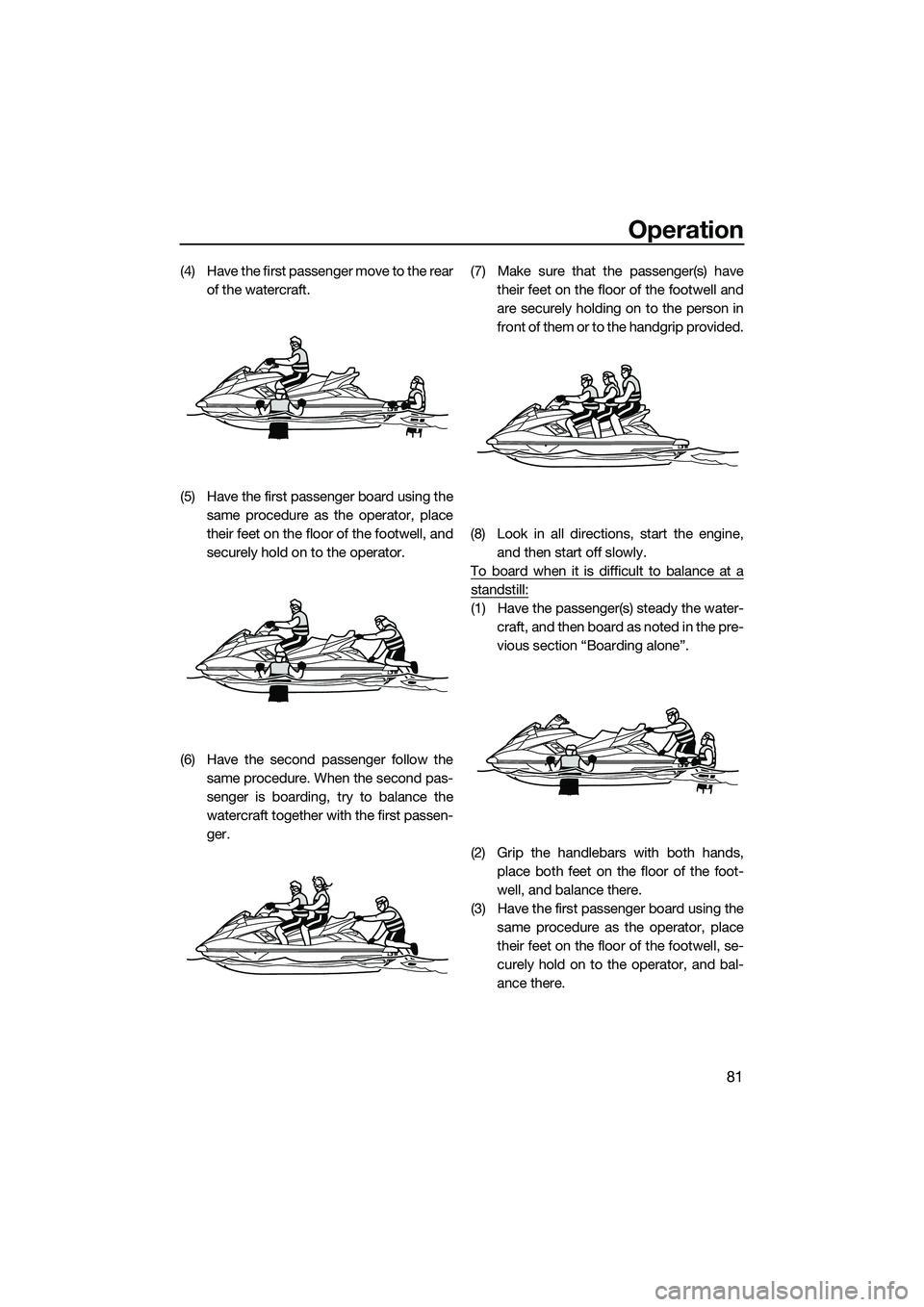
Operation
81
(4) Have the first passenger move to the rearof the watercraft.
(5) Have the first passenger board using the same procedure as the operator, place
their feet on the floor of the footwell, and
securely hold on to the operator.
(6) Have the second passenger follow the same procedure. When the second pas-
senger is boarding, try to balance the
watercraft together with the first passen-
ger. (7) Make sure that the passenger(s) have
their feet on the floor of the footwell and
are securely holding on to the person in
front of them or to the handgrip provided.
(8) Look in all directions, start the engine, and then start off slowly.
To board when it is difficult to balance at a
standstill:
(1) Have the passenger(s) steady the water- craft, and then board as noted in the pre-
vious section “Boarding alone”.
(2) Grip the handlebars with both hands, place both feet on the floor of the foot-
well, and balance there.
(3) Have the first passenger board using the same procedure as the operator, place
their feet on the floor of the footwell, se-
curely hold on to the operator, and bal-
ance there.
UF2T72E0.book Page 81 Monday, July 22, 2013 2:26 PM
Page 88 of 114
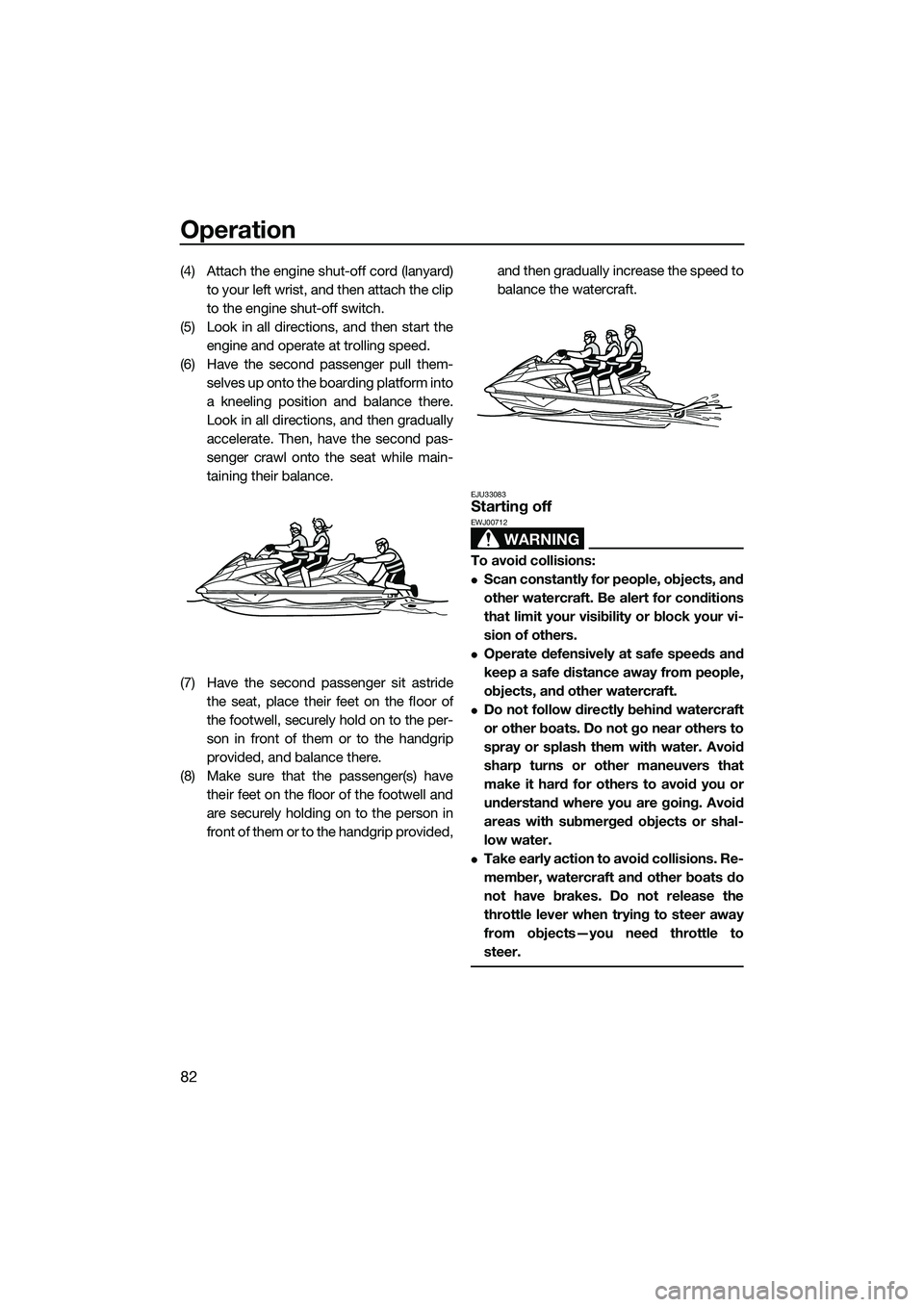
Operation
82
(4) Attach the engine shut-off cord (lanyard)to your left wrist, and then attach the clip
to the engine shut-off switch.
(5) Look in all directions, and then start the engine and operate at trolling speed.
(6) Have the second passenger pull them- selves up onto the boarding platform into
a kneeling position and balance there.
Look in all directions, and then gradually
accelerate. Then, have the second pas-
senger crawl onto the seat while main-
taining their balance.
(7) Have the second passenger sit astride the seat, place their feet on the floor of
the footwell, securely hold on to the per-
son in front of them or to the handgrip
provided, and balance there.
(8) Make sure that the passenger(s) have their feet on the floor of the footwell and
are securely holding on to the person in
front of them or to the handgrip provided, and then gradually increase the speed to
balance the watercraft.
EJU33083Starting off
WARNING
EWJ00712
To avoid collisions:
Scan constantly for people, objects, and
other watercraft. Be alert for conditions
that limit your visibility or block your vi-
sion of others.
Operate defensively at safe speeds and
keep a safe distance away from people,
objects, and other watercraft.
Do not follow directly behind watercraft
or other boats. Do not go near others to
spray or splash them with water. Avoid
sharp turns or other maneuvers that
make it hard for others to avoid you or
understand where you are going. Avoid
areas with submerged objects or shal-
low water.
Take early action to avoid collisions. Re-
member, watercraft and other boats do
not have brakes. Do not release the
throttle lever when trying to steer away
from objects—you need throttle to
steer.
UF2T72E0.book Page 82 Monday, July 22, 2013 2:26 PM
Page 89 of 114
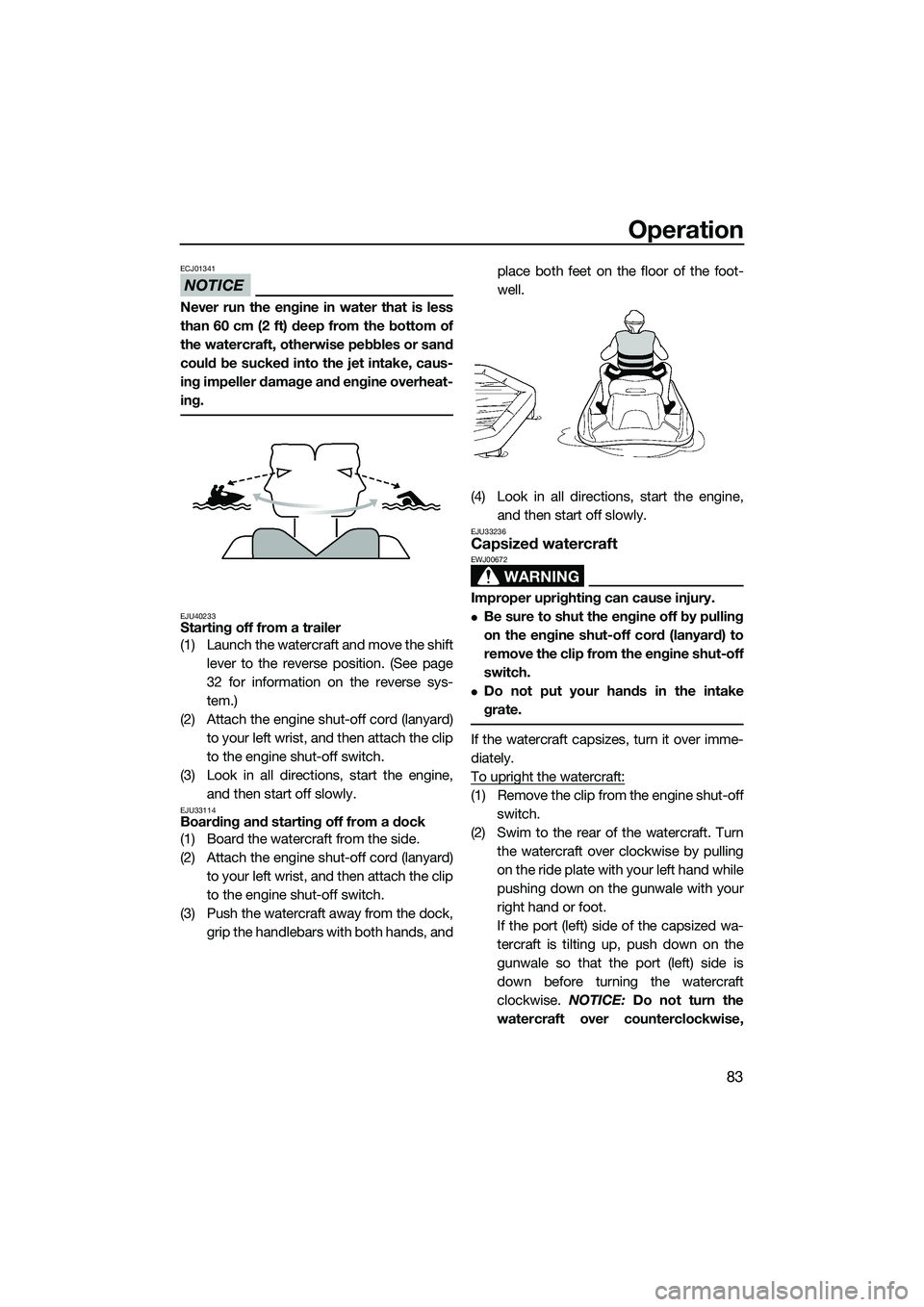
Operation
83
NOTICE
ECJ01341
Never run the engine in water that is less
than 60 cm (2 ft) deep from the bottom of
the watercraft, otherwise pebbles or sand
could be sucked into the jet intake, caus-
ing impeller damage and engine overheat-
ing.
EJU40233Starting off from a trailer
(1) Launch the watercraft and move the shiftlever to the reverse position. (See page
32 for information on the reverse sys-
tem.)
(2) Attach the engine shut-off cord (lanyard) to your left wrist, and then attach the clip
to the engine shut-off switch.
(3) Look in all directions, start the engine, and then start off slowly.
EJU33114Boarding and starting off from a dock
(1) Board the watercraft from the side.
(2) Attach the engine shut-off cord (lanyard)to your left wrist, and then attach the clip
to the engine shut-off switch.
(3) Push the watercraft away from the dock, grip the handlebars with both hands, and place both feet on the floor of the foot-
well.
(4) Look in all directions, start the engine, and then start off slowly.
EJU33236Capsized watercraft
WARNING
EWJ00672
Improper uprighting can cause injury.
Be sure to shut the engine off by pulling
on the engine shut-off cord (lanyard) to
remove the clip from the engine shut-off
switch.
Do not put your hands in the intake
grate.
If the watercraft capsizes, turn it over imme-
diately.
To upright the watercraft:
(1) Remove the clip from the engine shut-offswitch.
(2) Swim to the rear of the watercraft. Turn the watercraft over clockwise by pulling
on the ride plate with your left hand while
pushing down on the gunwale with your
right hand or foot.
If the port (left) side of the capsized wa-
tercraft is tilting up, push down on the
gunwale so that the port (left) side is
down before turning the watercraft
clockwise. NOTICE: Do not turn the
watercraft over counterclockwise,
UF2T72E0.book Page 83 Monday, July 22, 2013 2:26 PM
Page 90 of 114
![YAMAHA FX HO 2014 Manual Online Operation
84
otherwise water can enter the engine,
which can result in severe damage.
[ECJ00542]
(3) Start the engine and operate the water-craft at planing speed to drain the bilge
water from the eng YAMAHA FX HO 2014 Manual Online Operation
84
otherwise water can enter the engine,
which can result in severe damage.
[ECJ00542]
(3) Start the engine and operate the water-craft at planing speed to drain the bilge
water from the eng](/img/51/49764/w960_49764-89.png)
Operation
84
otherwise water can enter the engine,
which can result in severe damage.
[ECJ00542]
(3) Start the engine and operate the water-craft at planing speed to drain the bilge
water from the engine compartment.
(See page 58 for information on draining
the bilge water. If the engine does not
start, see “Towing the watercraft” on
page 104 or “Submerged watercraft” on
page 105.) NOTICE: Do not run the en-
gine at full throttle for at least 1 minute
after the engine has been restarted.
Bilge water in the engine compart-
ment can splash into the engine,
which can result in severe damage.
[ECJ00554]
EJU42591
Beaching and docking the watercraft
To beach the watercraft:
(1) Make sure that there are no boats, swim- mers, or obstacles near the beach. (2) Release the throttle lever to reduce
speed about 110 m (360 ft) before you
reach the intended beaching area.
(3) Slowly approach the beach and stop the engine just before reaching land.
WARNING! You need throttle to steer. Shutting the engine off can cause you
to hit an obstacle you are attempting
to avoid. A collision could result in se-
vere injury or death.
[EWJ00602] NOTICE:
Never run the engine in water that is
less than 60 cm (2 ft) deep from the
bottom of the watercraft, otherwise
pebbles or sand could be sucked into
the jet intake, causing impeller dam-
age and engine overheating.
[ECJ00473]
( 4 ) G e t o f f t h e w a t e r c r a f t a n d p u l l i t u p o n t h e beach.
To dock the watercraft:
(1) Make sure that there are no boats, swim- mers, or obstacles near the dock.
(2) Release the throttle lever to reduce speed about 110 m (360 ft) away from
the dock.
(3) Slowly approach the dock and stop the engine just before coming alongside it.
WARNING! You need throttle to steer. Shutting the engine off can cause you
to hit an obstacle you are attempting
to avoid. A collision could result in se-
vere injury or death.
[EWJ00602]
(4) Come alongside the dock and get off the watercraft.
EJU37194Operating in weeded areas
Always avoid using your watercraft in areas
where weed growth is thick. If operating in
weeded areas is unavoidable, alternately
squeeze the throttle lever and relax your grip
on the throttle lever to vary the engine speed.
Weeds tend to become clogged more when
operating at a steady speed and at trolling
UF2T72E0.book Page 84 Monday, July 22, 2013 2:26 PM